Seven of the top 17 states with the most rapid growth in the clean tech sector are considered swing states for the 2012 presidential election. Numbers like these suggest we are entering an era in which politicians who unfairly criticize or otherwise ignore clean tech run the risk of alienating a bedrock constituency: job holders, most of whom vote. We all need to understand that green jobs and clean tech are not merely the idle dreaming of a small group of partisan activists and insiders, but a source of livelihood for millions of Americans, literally in all parts of the country. What's more, their numbers are growing every day.
Nancy Pfund and Michael Lazar | DBL Investors
Executive Summary
Clean tech may mean a debate in Washington, but it means jobs everywhere else.
Washington D.C. may be the national capitol of the United States, but the political discussions there often have little in common with those taking place in the country as a whole. One of the many issues for which this is true is the relationship between the environment and the economy. Within the Beltway today, nearly everything associated with “clean tech” and “green jobs” is highly politicized—much like everything else. In general, Democrats support them. Republicans oppose them. End of story.
One might assume we’d find the same trend outside of Capitol Hill, with blue Democratic states rushing to embrace clean tech and green jobs, but with red Republican states resolutely declining to join in the action.
In fact, what we find is entirely different. The following maps tell the story. Map one shows that in the ten states where clean tech jobs are growing the most quickly, only two can be considered traditionally Democratic. Many of the remaining states are decisively Republican. The story is the same in map two when you look at the states where green jobs make up the biggest percentage of the labor force; only three of those and the District of Columbia are Democratic.
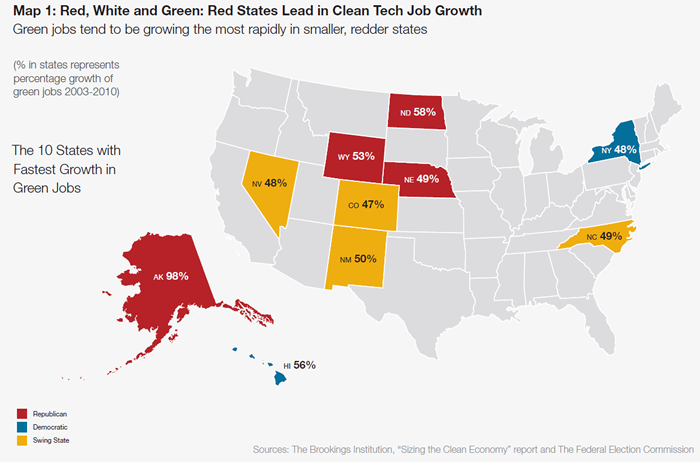
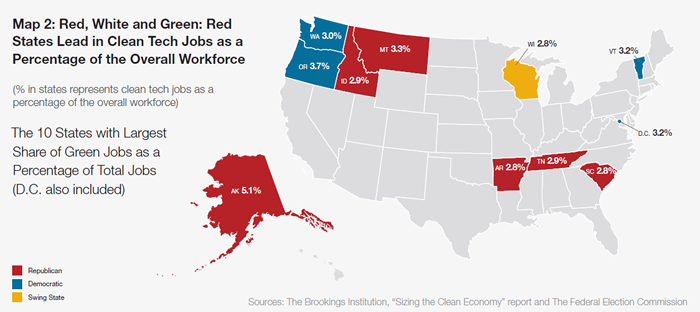
What’s more, many of the governors working the hardest to bring clean tech jobs to their home states are not only Republican, but are usually regarded as leaders of their party.
This demonstrates that clean tech and green jobs are only contentious inside Washington. Outside of the capital, where governors (and mayors) are more concerned with creating jobs than scoring debate points, there is no controversy about the impact of clean tech. It is almost universally appreciated as the important engine for job development and economic growth that it is. Disregarding the partisan bickering in Washington, these local officials are using clean tech to bring high-quality jobs to their states, in the process reviving communities and winning the support of local voters in both parties.
The on-the-ground reality of the economic importance of clean tech should serve as a reminder to journalists, pundits, policymakers and even politicians campaigning for office. Map three shown below underscores the political importance of green jobs by highlighting that in this election cycle seven of the top 17 fastest growing clean tech states are swing states. While it may be that on a D.C.-based cable news show, or inside a congressional committee hearing room, mentioning clean tech tends to immediately conjure up the capital’s gridlocked, right-left divide. Meanwhile, the rest of the country is often too busy working to attract and keep their green jobs to even notice the debate.
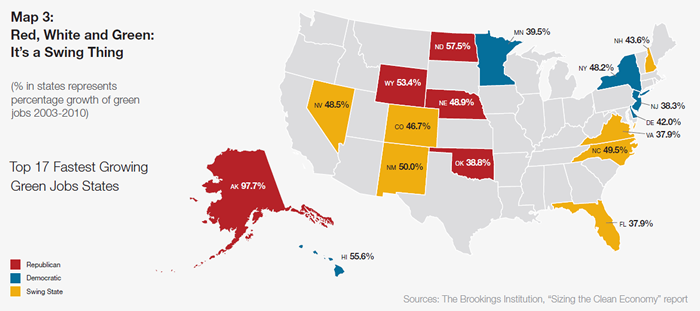
The data
Green jobs are growing the most quickly in some of the smallest and “reddest” states
A preliminary procedural note: Counting the number of green jobs in the United States means first coming up with a definition of whether a given job is in fact “green.” The Bureau of Labor Statistics has one definition: Jobs that either “produce goods or provide services that benefit the environment or conserve natural resources” or those that involve making a company’s production processes “more environmentally friendly” by using fewer natural resources.1
Some have criticized this definition as being overly-broad, suggesting it might include such disparate activities as tending an antique shop or lobbying for an oil company. Aware of this controversy, in 2011 the Brookings Institution came up with its own more restrictive definition.2 We use that narrower definition in this paper.
The data from the Brookings Institution, combined with information from other sources about economics, population and voting habits, points to a number of surprising, even counter-intuitive, observations.
1. Clean tech is already a significant source of employment everywhere in the country.
As expected, the states with the most green jobs are usually those with the biggest populations. Here are the top ten states in clean tech jobs; they are also among the top ten states in populations with two exceptions (Michigan and North Carolina). The major “outlier” is Washington, which ranks 13th in population.
To put these numbers in some perspective, it is worth noting that according to the National Mining Association, coal employs 136,000 people in the entire country.3 But three states all by themselves each have more clean tech workers than all the coal mining workers in the USA. The total number of Americans working in clean tech is many times the size of those in coal. This rarely-acknowledged statistic suggests that we broaden the national discussion of the economic effects of environmental policies. That discussion often emphasizes their impact on the coal industry, with the much-larger clean tech portion of the energy economy receiving proportionally much less attention.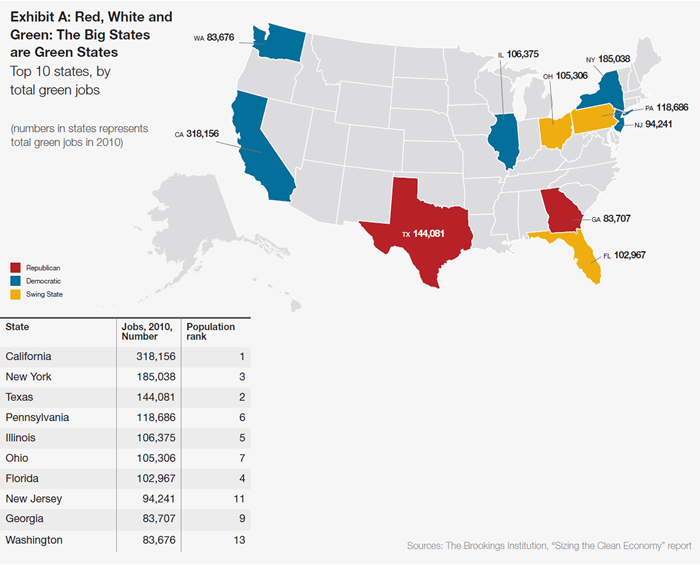
2. The most rapid growth in clean tech is taking place in smaller, red states.
The number of green jobs, on a percentage basis, tends to be growing the most rapidly in small, red states. The following table shows the top ten states ranked by percentage of green job growth; the final column shows the average GOP vote in each state in the presidential races of 2004 and 2008. (Recall the country as a whole was split roughly down the middle, especially in 2004.) Note that four of the states are solidly Republican, and a further four are close enough to be considered swing states. Note, too, that many of the states are among the least populous in the country. 4. Solar Energy Industries Association, “US Solar Industry Year in Review 2009” (April 15, 2010)
Also worth considering in the table below is the generally rapid rate of growth for green jobs everywhere in the country. In fact, the average growth rate for solar, which represents one big chunk of the clean tech sector, was 28 percent between 2006 and 2009, when both direct and indirect jobs are counted.4 Moreover, the entire solar industry employment growth between August 2010 and August 2011 was nearly ten times that of the overall economy at 6.8 percent v. 0.7 percent.5
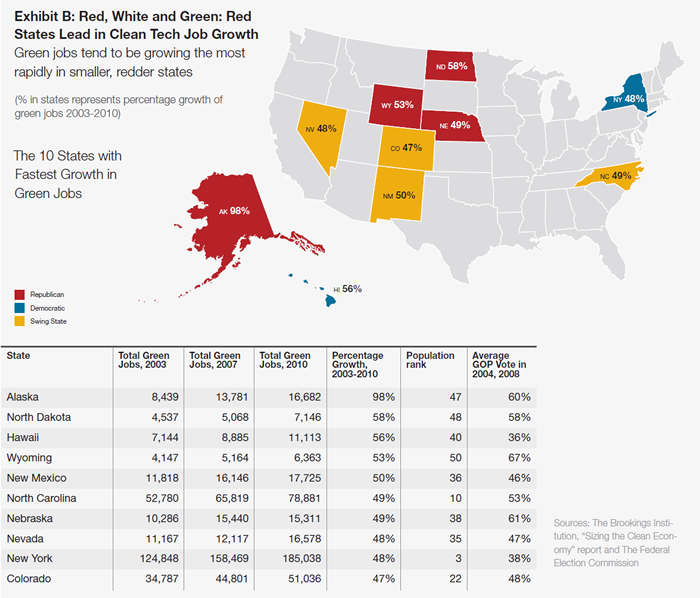
3. It is much the same story with states with the biggest percentage of non-farm jobs connected with clean tech: small, red states are over-represented.
As Exhibit C demonstrates, the numbers around the share of green jobs as a percentage of total jobs in 2010 are somewhat surprising: some of the least populated red states are the most dependent on green jobs. Many of the states with the biggest share of green jobs as a percentage of total non-farm jobs are less populated red states like Alaska and Montana.
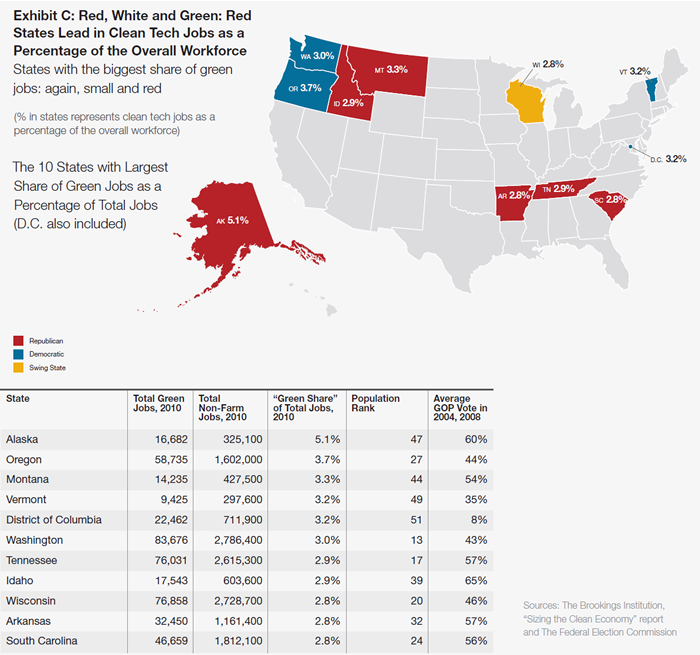
Real life outside out of the Beltway
Republican governors go green
Clean tech may be seen as a Democratic issue on Capitol Hill but out in the states, it has no political party. A number of Republican governors, as part of their overall economic development efforts, have embraced clean tech initiatives as a source of well-paying jobs, often in manufacturing. The pragmatism of governors—their willingness to do the right thing for their states regardless of current political fashions— may be one reason that pollsters generally find that governors, on the whole, have favorability ratings that are double those of prominent national politicians, and five times the approval afforded to the Congress.
We highlight here the clean tech efforts of five Republican governors. Of course, many Democratic governors have been equally aggressive in this regard. But we are not chronicling their efforts because they are, in some ways, less surprising. We also do not consider here the significant work done on behalf of Arnold Schwarzenegger during the eight years he spent as Republican governor of California. Also not included are Republicans Rick Scott of Florida, Mitch Daniels of Indiana and Jan Brewer of Arizona, all of whom have championed clean tech efforts in their states.
Readers with long memories should not be surprised by the active role being played by Republicans in environmentally- friendly economic development. For many years, the environment was a bipartisan issue. Indeed, some of the strongest pieces of environmental legislation were enacted during the presidency of Republican Richard Nixon. The polarized discussion of the environment is a relatively recent phenomenon, and, perhaps sadly, echoes the sharp divisions occurring throughout American political discourse.
Mississippi Former Governor Haley Barbour
Haley Barbour’s credentials in the GOP are impeccable; he is former chairman of the Republican National Committee and was head of the Republican Governors’ Association. Facing term limits, Governor Barbour left the governor’s mansion in 2012.
During his two terms, he helped make Mississippi a clean tech capital of the South. In the aftermath of Hurricane Katrina, Gov. Barbour aggressively moved to rebuild the Gulf economy, with green jobs playing an important role in his efforts.
For example, in 2011, Gov. Barbour announced an incentive package to bring 1,800 new jobs to the state.6 The package included a $75 million package to attract Calisolar Inc., now Silicor Materials, a silicon and aluminum manufacturer for the solar industry, to Columbus, bringing with it 951 full-time jobs with an expected average annual salary of $45,000 plus benefits. Also included in the program was a $100 million package for HCL CleanTech, now Virdia, a biomass and biofuels company, to be located in Olive Branch, near the Tennessee border. The company is expected to have a payroll of 800 jobs with an average salary of $67,000 plus benefits.
“Calisolar and HCL Cleantech are examples of how Mississippi has become a top site for high-tech, high-skilled manufacturing,” Gov. Barbour said.
Other efforts by the governor included a $75 million loan, along with tax and job training incentives, to lure solar startup Stion to the state.7 He even crossed party lines, working with Terry McAuliffe, former Democratic National Committee chair, to relocate the manufacturing facilities of GreenTech Automotive, a Chinese joint-venture plant, from China to Mississippi—in other words, in the opposite direction that manufacturing jobs usually flow.8 He also helped assemble economic development incentive packages that attracted Twin Creeks Technologies, which makes thin crystalline wafers for solar; 9 Kior, a biofuels company; 10 and Soladigm, a designer and manufacturer of electro-chromic windows.11
Gov. Barbour’s overall efforts in clean tech merited a profile in The New York Times, which called him “the driving force” behind Mississippi’s endeavors to become a clean tech leader.12 Residents of the state benefitted, as did Gov. Barbour himself: He left office with the highest approval rating of any governor in the nation.13
Kansas Governor Sam Brownback
Kansas Governor Sam Brownback has a national following in part from his 2008 presidential campaign, which while unsuccessful, made him popular with many Republicans, especially conservatives. Since then, he has spent much of his time actively recruiting clean tech jobs to Kansas, particularly in the field of wind energy.
This support has been very public. Gov. Brownback gave the keynote address at the June 2012 conference of the American Wind Energy Association.14 He also wrote an opinion piece in a major Kansas newspaper calling for the extension of the Production Tax Credit, a key clean tech policy we will discuss later.
“Kansas understands the positive impact that wind energy can make,” he told the delegates to the Wind Energy Association Convention. “More than 1,200 new, high-paying manufacturing jobs have been announced in Kansas in the last two years directly related to renewable energy. Kansas also has more wind energy construction projects underway than any other state, with at least 663 new turbines set to be installed and nearly $3 billion of new investment from 2011 to the end of 2012.”
In his Wichita Eagle op-ed, Gov. Brownback noted, “experience has taught us that investment in the renewableenergy economy is creating jobs across all employment technology and professional services, in both rural and urban communities.” 15
However statements like those might be received in Washington D.C., they are hardly controversial in Kansas.
New Jersey Governor Chris Christie
A relative newcomer to the political scene, Governor Christie has quickly attained a national following, so much so that he was frequently mentioned as a 2012 Republican candidate for both the presidency and the vice-presidency.
When at work in Trenton, Gov. Christie has championed clean tech. In June 2011, he released a draft of the State’s Energy Master Plan, which called for more investment in renewables.16 The governor is hoping to continue New Jersey’s rapid growth in the sector, with his office proudly boasting of each new milestone it reaches. Last July, for example, he issued a statement bragging of how New Jersey had become the second-largest solar market in the U.S., behind only California.17 And early this year, the governor was able to announce that New Jersey had moved into the lead, in large part because of a law he signed that mandated solar purchases by state utilities.18 In July of this year he signed a law calling for a percentage of power derived from solar in the state to double.19 Like Gov. Barbour, Gov. Christie has taken a bipartisan approach and was surrounded by Democrats as he signed the bill. At the time he said “Having renewable energy in our state, having it be a larger part of our portfolio, creating jobs, is not a Republican issue or Democratic issue. It’s an issue that the people of our state demand we work on together.” 20
Louisiana Governor Bobby Jindal
Bobby Jindal has built a reputation as an effective leader as governor of Louisiana following the devastation of Hurricane Katrina. In connection with his efforts to bring back the state’s economy following the disaster, Gov. Jindal has been a strong proponent of tax incentives to induce corporations to locate in Louisiana, including many in clean tech.
In part because of a business tax plan the governor unveiled earlier this year, the state is poised for a surge in green jobs over the next decade, according to the Louisiana Workforce Commission, with increases in green jobs far outpacing overall job growth.21 Researchers at Louisiana State University believe that five percent of the state’s jobs are already in the green category, a higher estimate than even the conservative one given by Brookings. Among the attractions making this possible: A 50 percent state credit on residential solar energy. Gov. Jindal is very public in his embrace of green jobs. In August 2010, he heralded the 600 new manufacturing jobs that would be created when Blade Dynamics, a wind turbine manufacturer, located its manufacturing in Michoud.22 He added that an additional 975 indirect jobs would also be created, both of which would result in a “huge economic win for New Orleans and our whole state.”
Texas Governor Rick Perry
Even with his prominent reputation as a conservative Republican, Texas Governor Rick Perry has a strong record of backing wind energy, along with gas and coal.23
During his tenure as governor, Texas has dramatically grown its share of energy from wind; it represented about eight percent of the state’s energy production in 2010. Those working in wind energy in Texas are among the 140,000 with green jobs in the state, the third-largest clean tech workforce in the country.
His predecessor, Gov. George W. Bush, had a similar commitment: the future president pushed for robust incentives for the wind industry, and partnered with the Texas legislature in 1999 to increase the role renewables played as an energy source for Texas. Gov. Perry has continued in that tradition, opening the state’s first biomass power plant and signing legislation increasing the state’s commitment to renewable energy.24
Maintaining the momentum
Key policy issues affecting the future of green jobs
For the clean tech economy to continue its growth, policies supporting long-term investment must be implemented at both the federal and state levels. Three of the most important of these are described here.
Keep the Solar Investment Tax Credit
The Solar Investment Tax Credit (ITC) provides a 30 percent tax credit for solar systems on both commercial and residential properties. It is probably the single most important solar-related energy policy now in place. According to the Solar Energy Industries Association, the Solar Tax Credit has been crucial in lowering the price of solar and creating jobs, and has helped give solar energy a 76 percent growth rate since its enactment in 2006.25
The credit is scheduled to decline to 10 percent by the end of 2016, in connection with other changes in tax law. Many argue that such a steep drop may disrupt the steadily improving economics of solar relative to other energy sources—energy sources that, contrary to popular belief, are themselves the benefit of very significant subsidies via corporate tax breaks and other mechanisms.26 As unsubsidized energy sources are a legitimate policy objective, several groups have suggested a much more gradual phase-out of the solar credit. One proposal calls for it to be phased out slowly, though the year 2025, at which time all energy sources are expected to be able to exist without any form of government help.27
Redraft tax legislation affecting clean tech-related Master Limited Partnerships and allow for solar REITs
Seemingly obscure portions of the tax code can have a dramatic effect on what is, or is not, invested in a field like clean tech. For example, experts say that laws like the ITC that are favorable to solar leasing arrangements, along with contracts known as “Power Purchase Agreements,” account for much of the recent growth in solar energy power sources.
Two other changes have been proposed and should be considered. The first would allow a Master Limited Partnership, which is a publicly traded partnership corporate ownership structure, to own and finance renewable energy and biofuel projects— something that can already be done with oil, gas and coal. As it would lower the financing cost for these projects, the idea has bipartisan support in Washington; earlier this year, a group of senators from both sides of the aisle introduced S.3275, known as the “MLP Parity Act,” which would enact the change into law.28
Similarly, many financial and solar industry advocates are calling for an expansion of the definition of Real Estate Investment Trusts (REITs) to include solar installations as a form of real property. Solar REITs would greatly expand the pool of capital available for solar projects, allowing for more solar projects to move from the planning to the actual construction stage.
Extend the Production Tax Credit
This may be the most immediately pressing issue of all. The Production Tax Credit has played a crucial role in the development of wind energy in the U.S. since its inception in 1992. However, the credit is set to expire at the end of this year. On account of the inevitable uncertainty about the credit’s future, new wind project development has slowed significantly this year, so much so that the CEO of Vestas, a wind energy company, predicts the wind turbine market to fall by up to 80% next year.29 In connection with that decline, Navigant Consulting estimated a net loss of 31,000 wind jobs from 2011 through 2014, of which about 7,000 are direct jobs in manufacturing, construction and operations.30 With wind as one of the most important of the renewable energy sources, not to mention the source of a considerable number of jobs, Congress would be wise to renew the credit before the year is out.
Conclusion:
Green jobs and the political discussion
We need to hear less from Capitol Hill and more from Main Street
Many people believe that supporting green jobs makes sensible policy, one that addresses our nation’s economic development, climate, and energy security needs. With the growing number of green jobs, it is also good politics. Seven of the top 17 states with the most rapid growth in the clean tech sector are considered swing states for the 2012 presidential election, as shown by the exhibit below. Numbers like these suggest we are entering an era in which politicians who unfairly criticize or otherwise ignore clean tech run the risk of alienating a bedrock constituency: job holders, most of whom vote. We all need to understand that green jobs and clean tech are not merely the idle dreaming of a small group of partisan activists and insiders, but a source of livelihood for millions of Americans, literally in all parts of the country. What’s more, their numbers are growing every day.
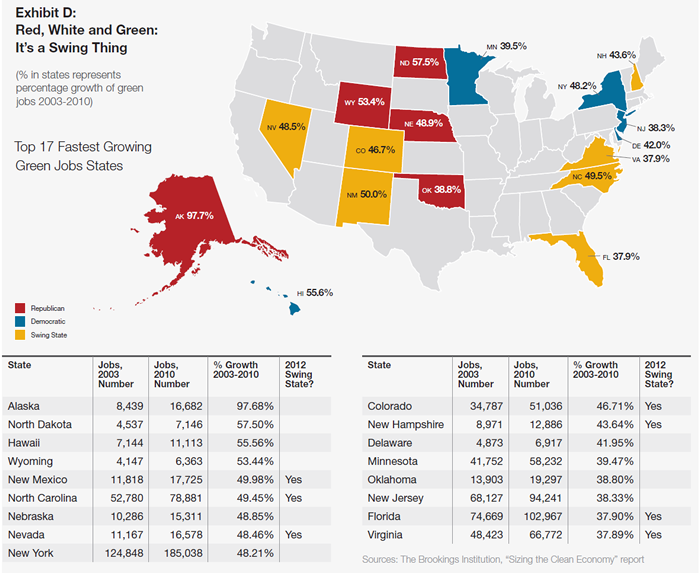
APPENDIX
The following data is derived from the Brookings Institution’s report, “Sizing the Clean Economy,” with the exception of the “Total Number of Nonfarm Payroll Sector Jobs 2010” column, which is from the US Bureau of Labor Statistics. Calculations derived from this data and included in this report are all on file with the authors and available upon request.
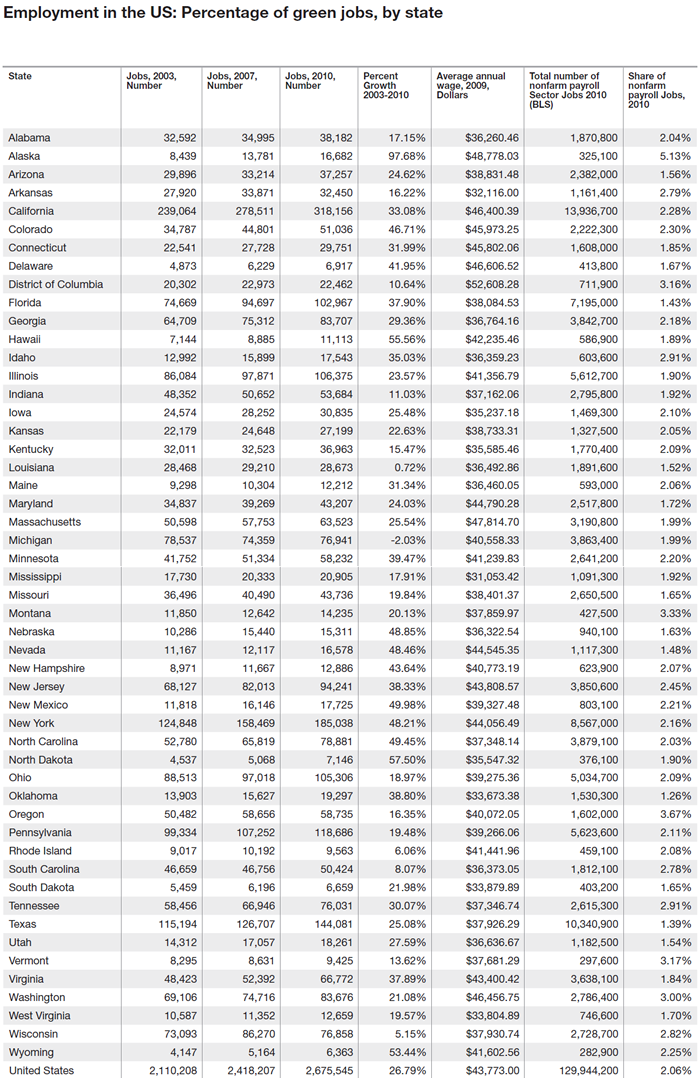
A list of original data sources follows below:
The Brookings-Battell Clean Economy Database as referenced in “Sizing the Clean Economy: A National and Regional Green Jobs Assessment” (2011) by Mark Muro, Jonathan Rothwell, and Devashree Saha with Battelle Technology Partnership Practice, Metropolitan Policy Program at the Brookings Institution. Federal Election Commission, Public Records Office,
“Federal Elections 2004” and “Federal Elections 2008” available at
http://www.fec.gov/pubrec/fe2004/federalelections2004.shtml and
http://www.fec.gov/pubrec/fe2008/federalelections2008.shtml
U.S. Bureau of Labor Statistics, Green Goods and Services Survey Database, last modified March 15, 2012, Retrieved from http://www.bls.gov/ggs/data.htm
References:
1. Available at http://www.bls.gov/green/green_definition.pdf
2. Mark Muro, Jonathan Rothwell, and Devashree Saha with Batelle Technology Partnership Practice, The Brookings Institution Metropolitan Policy Program, “Sizing the Clean Economy: A National and Regional Green Jobs Assessment” (2011). The definition referenced is- “The ‘green’ or ‘clean’ or low-carbon economy—defined as the sector of the economy that produces goods and services with an environmental benefit”
3. National Mining Association, “Fast Facts About Coal” (2012)
4. Solar Energy Industries Association, “US Solar Industry Year in Review 2009” (April 15, 2010)
5. The Solar Foundation, “National Solar Jobs Census 2011” (October 2011)
6. Office of Governor Barbour, The State of Mississippi, “Package to Bring Almost 1,800 Jobs to State to be Considered by Legislature Friday, Gov. Barbour Announces” (August 31, 2011) Retrieved from http://www.governorbarbour.com/news/2011/aug/8.31barbourcalisolarhclClean tech.html
7. Office of Governor Barbour, The State of Mississippi, “Gov. Barbour Announces Solar Panel Manufacturing Operations in Hattiesburg” (January 4, 2011) Retrieved from http://www.governorbarbour.com/ news/2011/jan/1.4barbourstionsolarpanels.html
8. Mark Leibovich, The New York Times, “Terry McAuliffe and the Other Green Party” (July 19, 2012)
9. Office of Governor Barbour, The State of Mississippi, “Governor Barbour Welcomes Renewable Solar Technology Firm to Senatobia” (April 2, 2010) Retrieved from http://www.governorbarbour.com/ news/2010/apr/4.2.
10solarfirmlocatesinms.html 10. Office of Governor Barbour, The State of Mississippi, “Gov. Barbour Welcomes Biofuel Producer to Mississippi” (August 26, 2010) Retrieved from http://www.governorbarbour.com/news/2010/ aug/8.26.10welcomeskior.html
11. Office of Governor Barbour, The State of Mississippi, “Governor Barbour Announces New Manufacturing Facility in Olive Branch” (July 30, 2010) Retrieved from http://www.governorbarbour.com/ news/2010/jul/7.30.10GovBarbourwelcomesSoladigm.html
12. Michael Kanellos, The New York Times Green Blog, “Mississippi Lures ‘Green’ Manufacturing Jobs” (September 8, 2011)
13. Public Policy Polling “Down to the wire on Personhood Amendment” (November 7, 2011)
14. “Governor Brownback Addresses WINDPOWER 2012 Conference” (June 4, 2012) retrieved from http://www.wibw.com/home/headlines/ Governor_Brownback_Addresses_WINDPOWER_2012_Conference_ 157006215.html
15. Gov. Sam Brownback, The Wichita Eagle, “Gov. Sam Brownback: Wind offers clean path to growth” (September 11, 2011)
16. Office of Governor Chris Christie, State of New Jersey, “Governor Christie Outlines Greener and More Affordable Vision for Future of Energy in New Jersey” (June 7, 2011) Retrieved from http://www. state.nj.us/governor/news/news/552011/approved/20110607a.html
17. Office of Governor Chris Christie, State of New Jersey, “Christie Administration Advances Commitment to Renewable Energy Development; New Jersey Surpasses Milestone of 10,000 Solar Installations” (June 25, 2011) Retrieved from http://www.state.nj.us/dep/ newsrel/2011/11_0088.htm
18. Solar Energy Industries Association and GTM Research, “Solar Market Insight Report 2012 Q1” (2012). New Jersey was ranked #1 in PV Installations by State for Q1 2012 with 174MW
19. Melissa Hayes, The New Jersey Record “Christie signs bill to help boost solar energy projects” (July 23, 2012). The law calls for an increase from about 2% to more than 4% by 2028.
20. Ibid. Hayes.
21. Naomi Martin, The Times-Picayune, “Green Jobs expected to grow in number in Louisiana” (September 27, 2011) By 2021, the Louisiana Workforce Commission study predicted “green” jobs will have grown by 13.8% and overall job growth will have grown 8%.
22. Robert Travis Scott, The Times-Picayune, “New green energy manufacturer to bring 600 jobs to Michoud” (August 2010)
23. Kate Galbraith, The Texas Tribune retrieved from The New York Times, “As Governor, Perry Backed Wind, Gas and Coal”(August 20, 2011)
24. Ibid. Galbraith. In 2005, Gov. Perry signed SB 20 requiring Texas to have 5,880 MW of renewables capacity by 2015
25. Solar Energy Industries Association, “The Case for the Solar Investment Tax Credit” (June 11, 2012)
26. Nancy Pfund & Ben Healey, “What Would Jefferson Do?: The Historical Role of Federal Subsidies in Shaping America’s Energy Future” (September 2011)
27. U.S. Partnership for Renewable Energy Finance, “Clean Energy and Tax Reform: How Tax Policy Can Help Renewable Energy Contribute to Economic Growth, Energy Security and a Balanced Budget” (2012)
28. United States of America Congressional Record, Volume 158, Number 85 (June 7, 2012)
29. John Acher, Reuters, “Update 1- Vestas CEO sees US market down 80 pct in 2013.” (June 10, 2012)
30. Navigant Consulting, prepared for the American Wind Energy Association, “Impact of the Production Tax Credit on the U.S. Wind Market” (December 11, 2011)
About the Authors:
Nancy Pfund is Managing Partner of DBL Investors, a venture capital firm located in San Francisco whose goal is to combine top-tier financial performance with meaningful social, economic and environmental returns in the regions and sectors in which it invests. She writes frequently on matters relating to clean tech and “impact investing.” Last year, she co-authored a widely-cited study showing that contrary to popular belief, current federal subsidy levels for alternative energy sources are in fact much lower than they ever were in the early days of “traditional” energy sources, such as coal, gas and nuclear.
Michael Lazar is an MBA candidate at the Yale School of Management. During the summer of 2012, Michael joined DBL Investors as a Summer Associate. Prior to Yale, Michael worked for the Glover Park Group, a strategic communications and political advocacy firm in Washington, D.C. Michael earned his BA from Stanford University.
Acknowledgements:
The authors would like to acknowledge Mark Muro, Senior Fellow and Policy Director, and Jonathan Rockwell, Senior Research Associate and Associate Fellow, Metropolitan Policy Program at The Brookings Institution; Donald Haughton, U.S. Bureau of Labor Statistics; U.S. Partnership for Renewable Energy Finance; Sarah M. Ham, DBL Investors; Yoni Cohen; and the E2Jobs project at E2/Natural Resources Defense Council.
The content & opinions in this article are the author’s and do not necessarily represent the views of AltEnergyMag
Comments (0)
This post does not have any comments. Be the first to leave a comment below.
Featured Product



